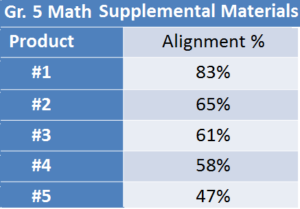When purchasing supplemental materials, how much weight should you give to the alignment percentage? In this blog, we explore the differences between comprehensive and supplemental materials when it comes to assessing alignment.
Educators in every district are working hard this year to close students’ Covid-19-related learning gaps. Consequently, many campuses and districts are selecting supplemental materials. This blog discusses important differences between supplemental and comprehensive (also referred to as core) materials to help set realistic expectations of supplemental materials.
As the blog discusses, one of the characteristics that define a high-quality comprehensive material is a high alignment percentage – the percentage of standards to which the material is aligned. Is the same true of supplemental materials?
The alignment of a material to the state standards is an indicator of whether the material teaches what the standards require students to learn. While it is just as important to consider the alignment of supplemental materials as it is core materials, the alignment percentage of supplemental materials may not be all-telling. Here’s why.

A supplemental material should be aligned to and provide sufficient practice for each of the standards you will use it to teach. But you may not be buying the supplemental material to teach all of the standards.
For example, is it critical for a science test prep material to be aligned to 100 percent of the grade-level science standards, or is more important for it to be aligned to and provide multiple activities for the standards that are eligible for assessment?
Similarly, if you are purchasing a material to provide students with intensive practice on fractions, do you need the material to be aligned to all grade level math standards – or is it more important for it to be aligned to and provide copious practice on just the standards that address fractions?
Because comprehensive materials are used as the primary material for the course, they should be aligned to the highest percentage of state standards possible. Supplemental materials, however, are used for more specific purposes. Thus, the percentage of standards to which a supplemental material is aligned is less important than whether the material is well aligned to the standards it will be used to teach.
For more guidance on selecting supplemental materials, see our whitepapers, “Navigating to Successful Student Outcomes with Standards-Aligned Instruction” and “Guidance for Selecting or Curating High-Quality Instructional Resources.”
